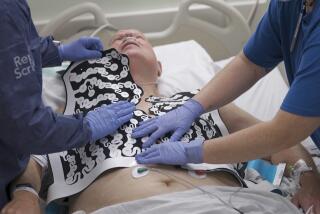Artificial Heart for Transplant Patients Gains New Life
- Share via
TUCSON — An artificial heart used to snatch patients from death’s door has been brought back from the brink itself by scientists who believe in how well it works.
A researcher says the U.S. Food and Drug Administration will be asked to approve broader use after trials have shown that the device keeps most dying patients alive long enough to have successful heart transplants.
“The numbers speak for themselves,” says Richard Smith, a biomedical engineer at the University of Arizona’s University Heart Center who heads the CardioWest artificial heart program.
Its current FDA-authorized investigational study is designed to prove that the heart replacement device works as a temporary bridge to a transplant in dying heart patients whom other heart-assist devices can’t save. The study involves medical centers in Chicago, Pittsburgh, Milwaukee, San Antonio and Salt Lake City, two in Paris and one in Ottawa, Canada.
“There’s enthusiasm out there. There’s need out there,” Smith said, adding that he gets inquiries weekly from heart surgeons.
Of 2,000 Americans who get transplants every year, about 25% to 35% need some mechanical assistance to stay alive beforehand. Most devices in use support only the heart’s left ventricle, its main pumping chamber.
When both sides of the heart are in failure, nothing else works as well as a total artificial heart, Smith said.
Since the first CardioWest heart pump was placed in Sharoyn Loughran’s chest in January 1993, 69 have been used worldwide, including 25 in the United States.
The device kept Loughran alive for 186 days before she got a transplant. Counting her, 65 patients met all criteria for the study. Of that number, 47 went on to receive transplants, and all but five are still alive.
Loughran, 49, thinks the device is great.
“It kept me alive, so I have to appreciate that,” she said from her home in Scottsdale. “But if anybody wants to break that record, they’re free to.”
Of the 25 CardioWest implants in the United States, 19 met all criteria for the study, and 17 are alive after subsequent heart transplants.
Smith said that means that an artificial heart implant offers transplant candidates with two-sided heart failure “a 90% chance that you’ll go home with a transplanted heart. And that’s good news.”
In each study case, he said, medical teams must show why other devices would not suffice.
Dr. Howard Frazier of Houston’s Texas Heart Institute, a transplant specialist not involved in the study, has said that the CardioWest fills a void and that “it’s good they’ve made this effort.”
The FDA counts not only the study’s domestic cases but tracks adverse events, from bleeding to death, in the foreign cases, Smith said.
The two-chambered CardioWest plastic pump is a direct descendant and improved version of the Jarvik heart. It replaces a patient’s own failing heart, handling the pumping chores of both the left and right ventricles.
As with the Jarvik, the CardioWest patient is tethered to a washing machine-sized, 500-pound air-powered console. Smith hopes to have a purse-sized portable drive unit within two years so patients awaiting transplant can go home.
The once-promising Jarvik heart appeared to reach a disastrous end by 1991. Less than a decade earlier, a University of Utah team riveted the world’s attention by implanting it in dentist Dr. Barney Clark as a permanent replacement heart in 1982. Clark died after 112 days.






